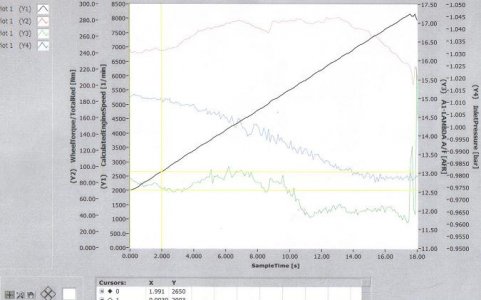Re: Reality check
There is not a single Japanese vender out there doesn't have a ECU upgrade when the BTB is offered, does that make and sense to you?
A quote for a SoS does not make the statement valid (not trying to rain on Chris's parade this time) but the study subject is "singular," therefore you will definitely need more than 1 to have a more clear picture.
In Japan, some ITB equipped NSX can get up to 400hp to the crank, but requires at lot more than just installation of ITB, a stroker kit is required. Without the stroker kit, the number appears to be around 320-ish HP to the crank. Even with that, it put the HP rating of the DOHC VTEC engine back to its potential even without ITB - 106-ish HP per liter. Honda has already achieved numbers even greater than that on the S2k.
For example, the TODA 3.5 package allows the RPM to reach 9500, that extra 1500 hundred RPM can easily translate to extra 30 hp. You can't achieve that with a stock NA motor even with just ITB.
Cars with TODA stroker kit with ITB and properly tuned ECU will not give the driver what he needs for daily street use. The application is strictly track purposed, the lower RPM power/torque curve is really really weak.
Regardless, you can compare BTB to ITB, they are completely different. People who have done ITB also have done pertty much every thing else that will benefit from ITB.
Think about it. M3/M5/M6 all use ITB, but they BMW did not offer any better HP output than what Honda can with standard TB.
So now I ask you, what proof do you have that the stock intake system is not restrictive at all on a motor with all the basic NA mods - or are you just posting pure speculation?
There is not a single Japanese vender out there doesn't have a ECU upgrade when the BTB is offered, does that make and sense to you?
A quote for a SoS does not make the statement valid (not trying to rain on Chris's parade this time) but the study subject is "singular," therefore you will definitely need more than 1 to have a more clear picture.
In Japan, some ITB equipped NSX can get up to 400hp to the crank, but requires at lot more than just installation of ITB, a stroker kit is required. Without the stroker kit, the number appears to be around 320-ish HP to the crank. Even with that, it put the HP rating of the DOHC VTEC engine back to its potential even without ITB - 106-ish HP per liter. Honda has already achieved numbers even greater than that on the S2k.
For example, the TODA 3.5 package allows the RPM to reach 9500, that extra 1500 hundred RPM can easily translate to extra 30 hp. You can't achieve that with a stock NA motor even with just ITB.
Cars with TODA stroker kit with ITB and properly tuned ECU will not give the driver what he needs for daily street use. The application is strictly track purposed, the lower RPM power/torque curve is really really weak.
There is a very simple way to determine if the stock TB & manifold are restrictive - do cars with ITBs make more power? If so, the answer is unequivocally yes; if not, then no. Its that simple.
My understanding, from speaking with Japanese nsx owners with ITBs on their cars, is that they (claim to) pick up anywhere from 15-25 hp on the dyno, depending on the other external modifications. Cams seem to be a big factor. I have not dyno tested a set of ITBs on a street car myself.
That said, I personally have no doubt that the intake system (as a whole) is less than ideal. It is designed based on a set of compromises that are not the same trade-offs desired by someone who's primary goal is more power. That does not make the oem design 'bad,' it is just a reality of production cars.
Regardless, you can compare BTB to ITB, they are completely different. People who have done ITB also have done pertty much every thing else that will benefit from ITB.
Think about it. M3/M5/M6 all use ITB, but they BMW did not offer any better HP output than what Honda can with standard TB.
Last edited:







